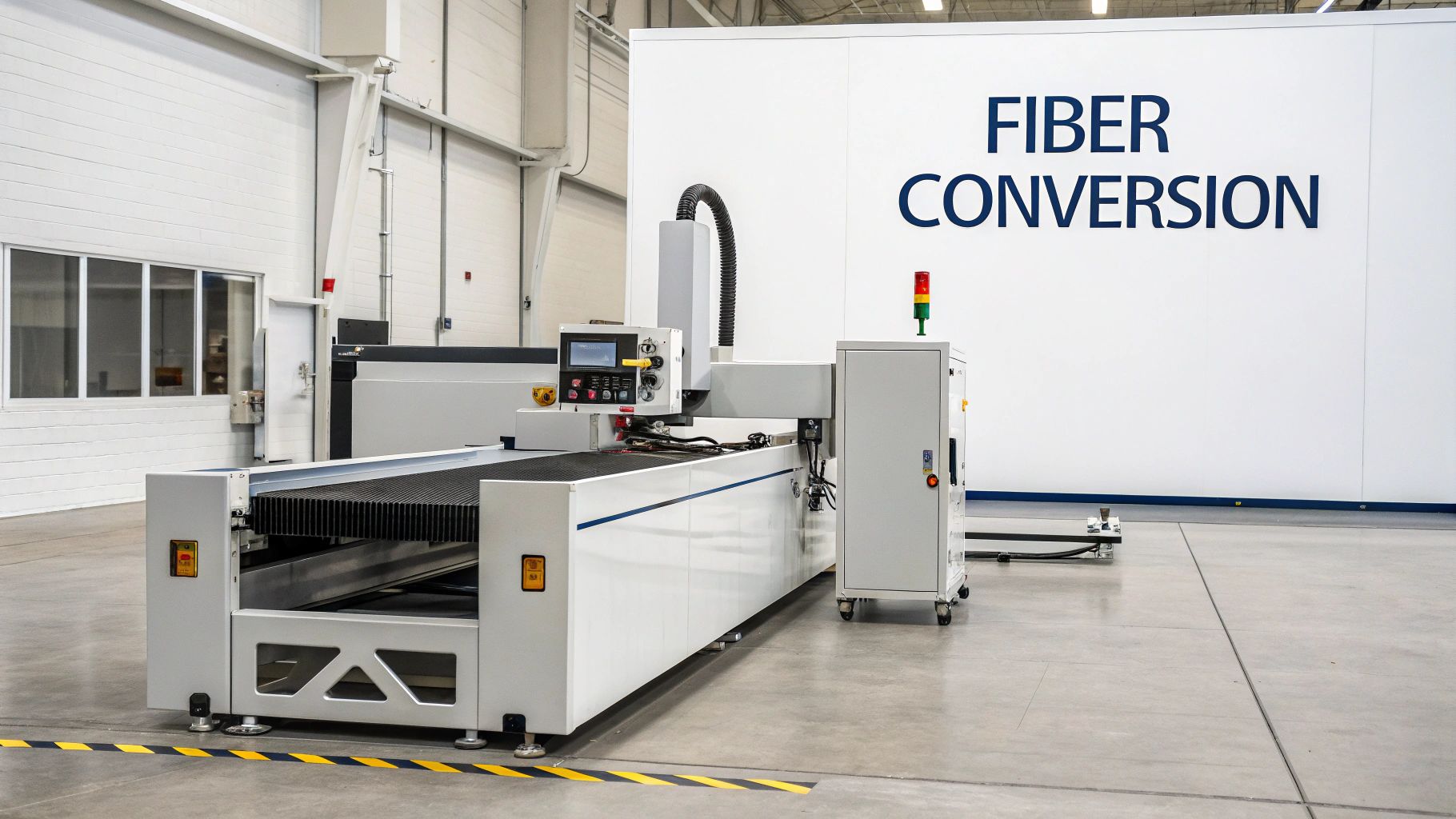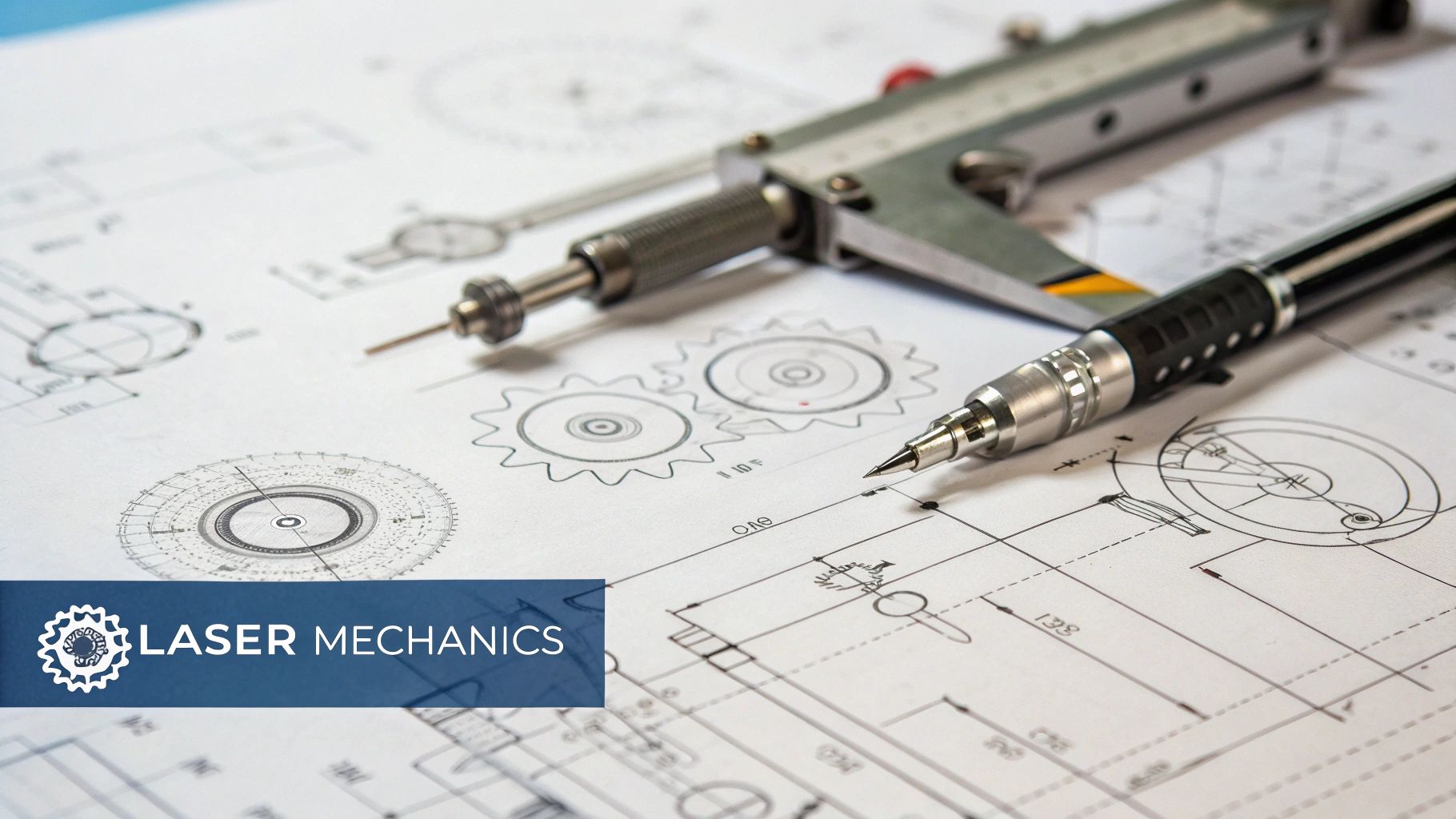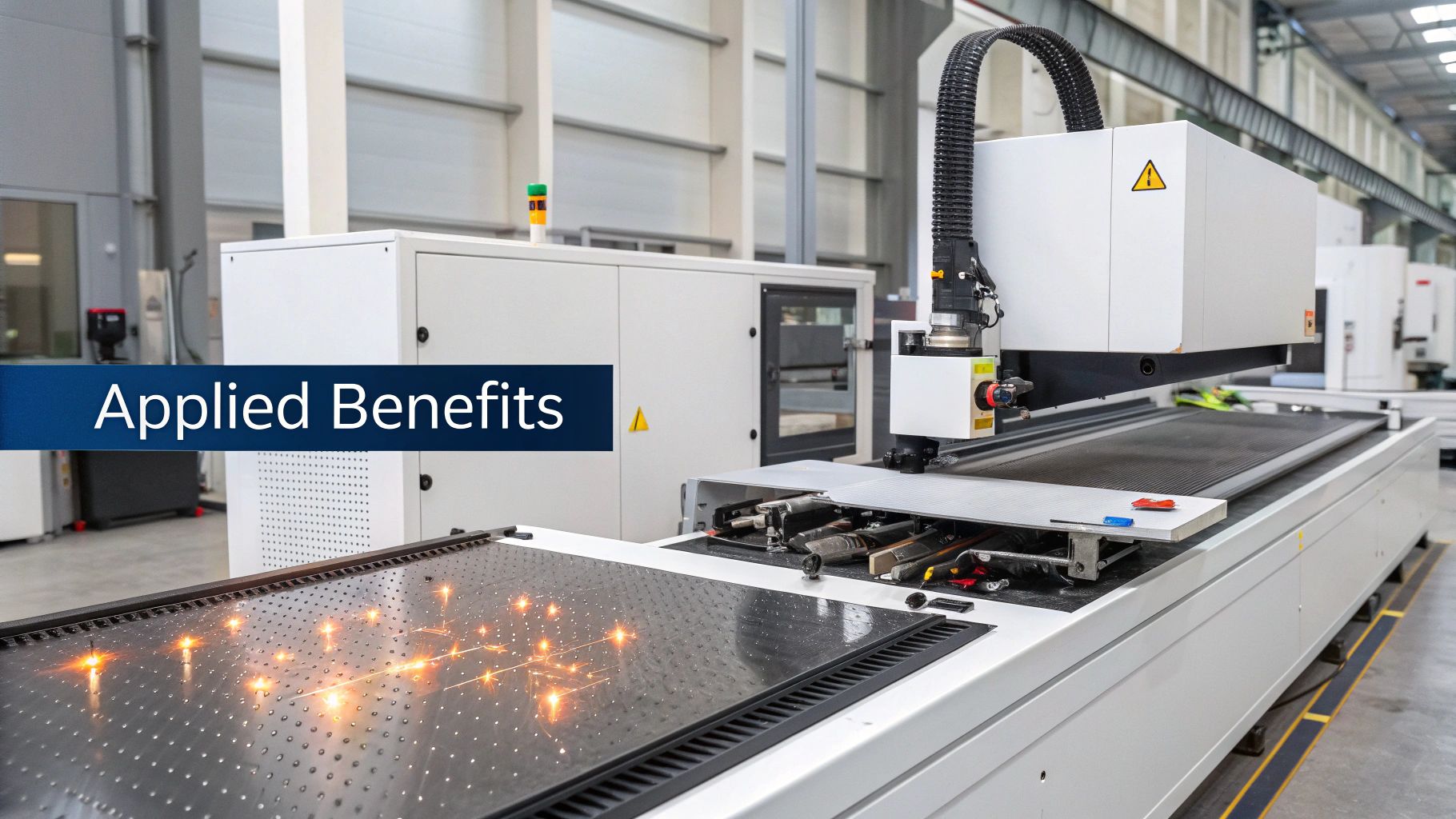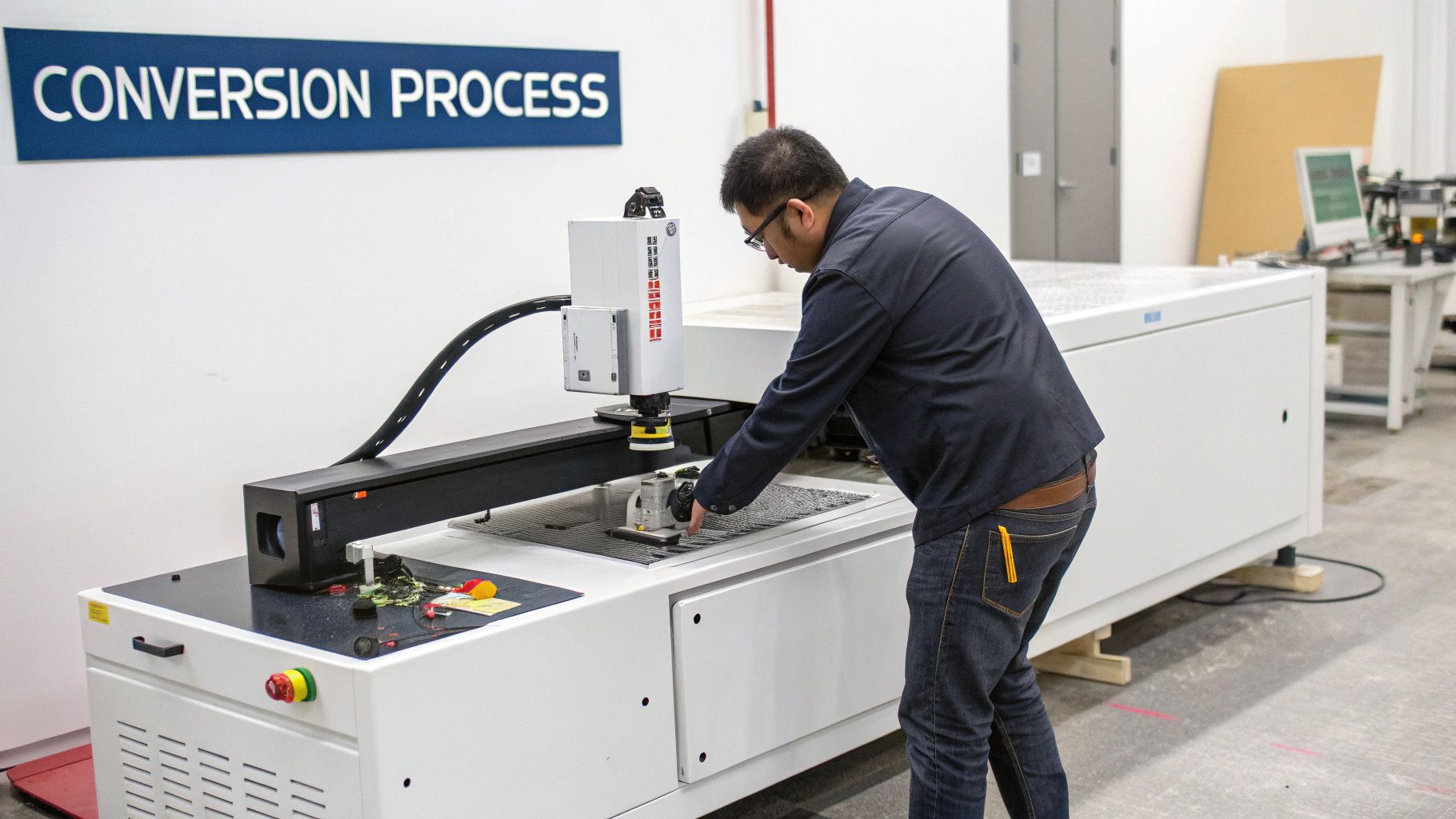Understanding Fiber Laser Conversion Fundamentals
Fiber laser conversion is significantly impacting manufacturing. Many manufacturers are transitioning from traditional laser systems to this upgraded technology. This raises the question: what distinguishes fiber lasers, and why are they gaining preference?
Core Components of a Fiber Laser System
A fiber laser's performance stems from its unique components. Unlike traditional CO2 or YAG lasers, fiber lasers employ a specialized optical fiber as the gain medium. This fiber, doped with rare-earth elements like ytterbium, amplifies light internally. This contrasts sharply with traditional lasers, which use gas mixtures or crystals.
Fiber lasers also utilize advanced beam delivery mechanisms. These mechanisms ensure a highly focused and consistent beam, crucial for precision. This targeted energy delivery maximizes efficiency and minimizes waste. For more about laser technology, explore our collection of blog posts.
How These Components Work Together
The interplay of these components creates a highly precise and efficient laser system. The doped fiber amplifies light more effectively than traditional gain media. The precise beam delivery ensures optimal use of this amplified light. This results in faster processing, finer details, and less material waste – all significant advantages for manufacturers. The compact and robust design of fiber lasers further enhances their appeal.
Market trends reflect this growth. Fiber lasers have become essential in modern manufacturing due to their precision and efficiency. The global fiber laser market reached USD 3.50 billion in 2023. Projections indicate growth to USD 8.53 billion by 2031, with a 12.0% CAGR during this period. More statistics are available here. This underscores the growing recognition of fiber lasers as a powerful manufacturing tool. Ongoing research and development continuously push the boundaries of fiber laser technology.

Compelling Benefits That Drive Fiber Laser Adoption

Manufacturers are increasingly integrating fiber lasers into their operations, and the reasons are clear. This section explores the practical advantages that make this technology a worthwhile investment, transforming real-world manufacturing processes.
Enhanced Precision and Quality
One of the most significant benefits of fiber lasers is their exceptional precision. This stems from the very nature of the technology itself. The highly focused laser beam allows for incredibly accurate material processing. This precision translates directly into higher quality products, often exceeding the capabilities of traditional laser systems.
Improvements in precision can reach up to 30%, significantly impacting the final product. This increased accuracy allows manufacturers to create more intricate designs and explore more complex applications. For more information on optimizing performance, consider reading this article on Boosting Application Performance.
Superior Energy Efficiency
Fiber lasers are not only precise but also incredibly energy-efficient. They offer a remarkable 70%+ increase in energy efficiency compared to CO2 lasers. This efficiency stems from the fiber's ability to effectively convert electrical energy into laser light.
This efficiency results in significant cost savings on electricity consumption, making fiber lasers a more sustainable choice for environmentally conscious manufacturers. This aligns with the growing demand for greener manufacturing processes.
Reduced Maintenance and Extended Service Life
Fiber laser systems require significantly less maintenance compared to traditional CO2 lasers. Their robust, sealed design minimizes contamination and component degradation, reducing the need for frequent servicing and minimizing downtime.
This extended lifespan makes fiber lasers a smart long-term investment. The longevity of core components reduces overall maintenance expenses, further adding to the cost-effectiveness of these systems.
Improved Beam Quality and Reduced Downtime
Fiber lasers deliver superior beam quality, crucial for various applications. This high quality allows for finer details and more consistent results. The concentrated energy delivery minimizes material waste and reduces the need for post-processing, streamlining the manufacturing workflow.
The robust design of fiber lasers contributes to minimal downtime. Less time spent on maintenance means more time dedicated to production, increasing overall productivity and efficiency.
To understand the key differences between fiber lasers and other laser types, let's examine a comparison table:
Fiber Laser vs. Traditional Laser Comparison: A side-by-side comparison of key performance metrics between fiber lasers and traditional CO2/YAG lasers.
| Performance Metric | Fiber Laser | CO2 Laser | YAG Laser |
|---|---|---|---|
| Precision | Very High | Moderate | Moderate |
| Energy Efficiency | Very High | Low | Moderate |
| Maintenance | Low | High | Moderate |
| Service Life | Long | Moderate | Moderate |
| Beam Quality | Excellent | Good | Good |
| Operating Cost | Low | High | Moderate |
This table highlights the advantages of fiber lasers in several key areas, including precision, energy efficiency, maintenance, and operating costs. While other laser technologies offer specific benefits, fiber lasers demonstrate a compelling combination of desirable characteristics for modern manufacturing.
Industry Leaders Transforming Through Fiber Laser Conversion
Fiber laser conversion is changing how industries operate, offering significant boosts in speed, precision, and overall efficiency. This section explores how leaders in various sectors are using this technology to achieve remarkable outcomes.
Automotive Advancements With Fiber Lasers
The automotive industry has adopted fiber laser technology for numerous applications. From precisely cutting and welding car body panels to crafting intricate engine and transmission parts, fiber lasers provide remarkable accuracy and speed. Some manufacturers report a 40% reduction in processing time with simultaneous improvements in weld quality. This increased efficiency translates to higher production volumes and reduced manufacturing expenses.
Additionally, fiber lasers simplify processing high-strength steel and aluminum alloys, materials increasingly common in modern vehicles. They handle these materials with greater ease and precision than traditional methods, allowing for lighter, stronger vehicle designs which improve fuel efficiency and safety.

Aerospace Precision With Fiber Laser Technology
The aerospace industry demands exceptional precision and reliability. Fiber lasers fulfill these strict requirements, enabling accurate cutting and welding of specialized alloys found in aircraft components. This precision is essential for creating intricate shapes and guaranteeing the structural integrity of vital parts.
Furthermore, fiber lasers minimize heat-affected zones during processing, lowering the chances of material distortion and warping. This is especially important when dealing with sensitive aerospace materials. For more information, check out this resource: How to master....
Electronics Production Enhanced by Fiber Lasers
Fiber lasers are transforming electronics production, particularly in microprocessing. Their ability to create exceptionally fine features with high precision makes them perfect for producing microchips and other electronic parts.
The non-contact nature of fiber laser processing also minimizes contamination risks, a crucial factor when manufacturing sensitive electronics. This cleanliness, coupled with high throughput, makes fiber lasers a valuable tool in high-volume electronics manufacturing. The increasing demand for precision and speed in sectors like automotive, aerospace, and electronics is driving the expansion of the fiber laser market. This growth is evident in the rising use of fiber lasers for tasks like cutting and welding automotive parts with improved accuracy.
Emerging Sectors Embracing Fiber Lasers
Beyond established industries, emerging sectors are also recognizing the advantages of fiber lasers. Medical device manufacturing benefits from the ability to create complex, biocompatible parts with micron-level precision.
The renewable energy sector is also exploring the use of fiber lasers in the production of solar panels and other clean energy technologies. These early adopters gain a competitive edge by implementing these innovative solutions. This forward-thinking strategy sets them up for future success and market leadership.
Creating Your Fiber Laser Conversion Roadmap
A successful fiber laser conversion requires thoughtful planning and execution, not a hasty decision. This guide helps you create a practical conversion roadmap, transforming your interest in fiber lasers into a concrete implementation plan.
Initial Process Evaluation
Begin by thoroughly evaluating your current manufacturing processes. Identify processes using traditional lasers and analyze their performance. Consider factors like processing speed, precision, material waste, and energy consumption. This assessment creates a baseline to measure the potential benefits of fiber laser conversion.
- Identify laser-dependent processes: List all operations using laser technology.
- Analyze performance: Evaluate key metrics, including speed, precision, and efficiency, for each process.
- Document current limitations: Note any bottlenecks or areas needing improvement.
This evaluation builds the foundation of your business case and helps identify processes that would benefit most from fiber lasers.
Identifying High-Impact Conversion Opportunities
Not all processes are equal. Some will gain more from fiber laser conversion. Focus on processes where fiber laser benefits, like increased precision, higher speed, and improved energy efficiency, directly address limitations or create new possibilities.
- Prioritize processes with high potential ROI: Seek applications where fiber lasers offer substantial improvements.
- Consider material compatibility: Ensure the fiber laser suits your materials.
- Evaluate production volume: High-volume processes are excellent candidates for fiber laser automation.
Prioritizing high-impact opportunities maximizes your return on investment and quickly realizes the advantages of fiber laser technology.
Building a Compelling Business Case
A strong business case is crucial for securing approval for your fiber laser conversion. Highlight the technical benefits and quantify the financial returns. Use ROI calculation frameworks to show long-term cost savings from reduced energy consumption, lower maintenance, and increased throughput.
- Quantify cost savings: Estimate reductions in energy, maintenance, and material costs.
- Project increased productivity: Calculate the potential output increase due to faster processing speeds.
- Present a clear ROI timeline: Show how quickly the investment will pay for itself.
A well-structured business case provides a strong argument for investment, ensuring successful implementation.
Timeline Planning and Integration Strategies
Minimize production disruptions during conversion. Careful timeline planning, including installation time, staff training, and integration with existing systems, is essential.
- Develop a phased implementation plan: Break the conversion into smaller stages to minimize disruption.
- Schedule staff training: Ensure operators are proficient with the new technology before full implementation.
- Plan for system integration: Address compatibility issues with existing equipment and software.

A well-defined roadmap, including these planning and implementation steps, ensures a smooth transition to fiber laser technology, maximizing its potential to improve your manufacturing operations. This allows your company to benefit from fiber laser advancements while maintaining efficient workflows.
Technical Mastery for Successful Fiber Laser Implementation
Successfully implementing a fiber laser system involves more than just setting up the equipment. It requires careful consideration of several technical aspects, which are often overlooked by those unfamiliar with the technology. This section explores these key engineering decisions, based on insights from experienced professionals.
Power Requirement Calculations
Accurately calculating power requirements is crucial. Underestimating power needs can result in a system that doesn't perform adequately, leading to costly rework. Overestimating, on the other hand, means spending unnecessarily on a more powerful laser than needed.
Precise calculation involves analyzing the specific materials being processed, their thickness, and the desired cutting or welding speeds. For instance, thicker materials and higher speeds require greater laser power.
Cooling System Design
Fiber lasers generate heat during operation, so an efficient cooling system is essential for optimal performance and preventing damage. The cooling system design must account for the laser's power output, the surrounding temperature, and the application's duty cycle.
High-power lasers in demanding applications often require advanced liquid cooling systems. Less demanding applications with lower-power lasers might only need simpler air-cooled systems. Evaluating these variables is essential for selecting the correct cooling approach.
Safety System Integration
Safety is paramount with laser systems. Integrating proper safety measures, such as interlocks, beam enclosures, and laser safety eyewear00002-5/fulltext), is crucial to protect personnel and prevent accidents. These safety systems should adhere to relevant industry standards and regulations.
Beam Delivery and Control System Compatibility
How the laser beam reaches the workpiece significantly affects the final result. This involves choosing the right optics, lenses, and mirrors for the specific application. For more insights, refer to our article on How to Master....
The control system needs to be compatible with both the fiber laser and any other automated equipment to ensure smooth integration and efficient operation. Selecting a controller with the appropriate interface and programming capabilities is essential for successful implementation. Fiber laser technology has also found applications in power systems like Power over Fiber (PoF), transmitting laser power through optical fibers for conversion to electricity.
Retrofit vs. Replacement and Facility Modifications
Switching to a fiber laser may involve retrofitting an existing system or replacing it entirely. The best approach depends on the condition of the current equipment, the scope of the conversion, and budgetary constraints.
Facility modifications, such as electrical upgrades or adjustments to material handling systems, may be needed to accommodate the new fiber laser system. Evaluating these requirements in advance helps prevent unexpected delays and costs, ensuring project goals align with realistic expectations.
Material Handling and Troubleshooting
Efficient material handling is vital for maximizing productivity and minimizing downtime. This often involves integrating suitable automation equipment like robotic arms, conveyor belts, and automated loading systems.
Effective troubleshooting and performance optimization are also essential. This includes regular maintenance, calibration, and understanding the system's diagnostic capabilities. These practices help ensure efficient operation and extend the equipment's lifespan.
To help illustrate typical fiber laser power requirements for various manufacturing processes, the following table provides a useful overview.
Fiber Laser Power Requirements by Application Typical power levels needed for different manufacturing processes when using fiber laser technology
| Application | Recommended Power (W) | Material Thickness Range | Key Considerations |
|---|---|---|---|
| Laser Cutting (Thin Sheet Metal) | 1000 - 3000 | 0.5mm - 3mm | Cutting speed, edge quality, material type |
| Laser Cutting (Thick Plate) | 3000 - 6000 | 3mm - 25mm | Piercing time, kerf width, assist gas pressure |
| Laser Welding (Spot Welding) | 500 - 2000 | 0.1mm - 2mm | Weld penetration, heat input, material compatibility |
| Laser Welding (Seam Welding) | 1000 - 4000 | 1mm - 5mm | Welding speed, joint design, filler material |
| Laser Engraving | 20 - 100 | N/A | Marking depth, resolution, material reflectivity |
| Laser Marking | 50 - 500 | N/A | Mark contrast, durability, processing speed |
This table summarizes the general power ranges suitable for different fiber laser applications. Actual power needs will vary depending on specific material properties, desired processing speeds, and other process parameters. Carefully assessing these factors is essential for optimal system performance.
Pioneering Applications Pushing Fiber Laser Boundaries
Fiber laser conversion isn't just about upgrading existing equipment; it's about opening up a whole new world of manufacturing possibilities. This technology is constantly evolving, with innovative manufacturers finding exciting new applications in diverse industries. Let's explore some of these groundbreaking uses that are reshaping the future of manufacturing.
Additive Manufacturing With Unprecedented Precision
Fiber lasers are essential to the progress of additive manufacturing, commonly known as 3D printing. Their highly concentrated beams allow for incredibly precise melting and layering of materials, resulting in intricate and complex parts with unparalleled accuracy. This is a game-changer for industries like aerospace and medical device manufacturing, which demand highly customized or complex components.
Medical device manufacturers, for example, can now create life-saving components with tolerances measured in microns. This level of precision allows for the development of smaller, more intricate devices for minimally invasive procedures. It also enables the production of highly customized implants and prosthetics, ultimately leading to improved patient outcomes.
Micro-Machining: Creating the Impossible
The precision of fiber lasers extends to micro-machining, where they create features once thought impossible. These lasers produce exceptionally fine cuts and detailed patterns on a microscopic scale, unlocking new possibilities for electronics, microfluidics, and other high-precision industries.
The semiconductor industry, for instance, is using fiber lasers to create the next generation of smaller, faster, and more efficient computer chips. These lasers can precisely etch circuits onto silicon wafers, enabling the intricate circuitry required for these advanced devices.
Surface Texturing: Beyond Aesthetics
Fiber laser conversion is also revolutionizing surface texturing, offering functional advantages along with aesthetic improvements. By meticulously controlling the laser beam, manufacturers can create specific surface textures that enhance product performance. These textures can improve grip, minimize friction, or optimize fluid flow.
This technology finds applications in the automotive industry, where surface texturing improves the performance of engine components by refining oil flow and reducing wear. It's also used in the renewable energy sector to create textured surfaces on solar panels, maximizing light absorption and improving energy generation efficiency. For example, power over fiber (PoF) systems are gaining traction. These systems transmit laser power over optical fibers, converting it into electricity using photovoltaic cells. This technology powers remote sensors, UAVs, and other high-reliability applications. High-power diode lasers in PoF systems have expanded their potential in high voltage monitoring and RF over fiber systems.
Transforming Renewable Energy Production
Fiber lasers are changing how renewable energy products are manufactured. Their precision and efficiency are vital for producing high-quality solar panels and other clean energy technologies. By accurately cutting and welding specialized materials, fiber lasers facilitate the creation of more efficient and durable solar cells.
This contributes to the increased adoption of renewable energy sources and plays a significant role in developing more sustainable and efficient power generation. The advancements in fiber laser technology are accelerating the shift toward cleaner energy solutions.
The Future of Fiber Laser Applications
These examples demonstrate the transformative power of fiber laser conversion. As the technology continues to evolve, we can expect even more innovative applications to appear. This ongoing development promises to reshape manufacturing processes across various industries, pushing the limits of what's possible.
Ready to explore how fiber laser conversion can benefit your manufacturing processes? Discover more about Laser Insights China, a leading resource for in-depth information on laser technologies and advancements.

